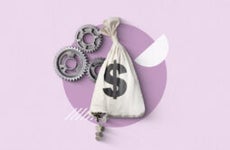How much will an unsecured business loan cost?

The Bankrate promise
At Bankrate we strive to help you make smarter financial decisions. While we adhere to strict , this post may contain references to products from our partners. Here's an explanation for .
Key takeaways
- Unsecured business loans do not require collateral
- Interest rates and fees impact how much an unsecured loan costs
- Paying extra every month could save on the cost of borrowing if the lender doesn't charge prepayment penalties
When you take out an unsecured business loan, you don’t have to provide collateral to secure the loan. Since the lender doesn’t have an asset that it can claim if you default on the loan, unsecured business loans tend to cost more than secured business loans. But how much an unsecured loan will cost depends on several factors.
Unsecured business loan cost: Interest rates
When you take out any loan, one of the biggest factors that impact its cost is the interest rate. Expect rates to be higher than secured loans since the lender takes on more risk by offering an unsecured loan.
An unsecured loan can have simple or compound interest.
Simple interest is charged as a percentage of the total loan amount, interest rate and loan length. For example, if you have a $10,000 loan with a 5 percent interest rate, you would pay a total of $500 in interest every year you hold on to the loan. If paying off the loan takes three years, you’d pay $1,500 in interest ($500 x 3 years).
Compound interest is the most common way that lenders charge interest. When interest compounds, you have to pay interest on the principal and the interest that accumulates on the remaining balance.
How does this work? Let’s say you have a $10,000 loan with a 5 percent interest rate that compounds annually. If the loan has a term of five years, the total interest over the life of the loan will be $1,322.74. You can use a business loan calculator to see for yourself how interest compounds with different loan amounts.
Want to know more about business loan interest rates? Check out our guides for more information:
APR
The annual percentage rate (APR) is the yearly cost of a business loan. It includes the interest rate and loan fees and is expressed as a yearly percentage rate. Since it offers a more complete picture of your total loan costs, APR rates look higher than interest rates.
Factor rates
A factor rate is another way to define the cost of a business loan. It’s more commonly found with short-term business loans or cash advances.
Unlike interest rates, factor rates are expressed as decimals. To find the total repayment amount with a factor rate, multiply the loan amount by the factor rate:
Loan amount x factor rate = total repayment amount
So, if a loan has a factor rate of 1.2 and the loan is for $10,000, you will need to repay a total of $12,000 ($10,000 x 1.2 = $12,000), not counting any additional fees.
You should convert a factor rate to an APR to compare different loans and to get an idea of how expensive loans with factor rates can be compared to interest rates or APR.
Unsecured business loan cost: Fees
You’ll also need to consider business loan fees when looking into an unsecured business loan, as these will vary by lender. Here are just a few common fees you may encounter:
| Annual fee | Some lenders charge a fee each year for business lines of credit to keep them active. |
| Application fee | You may be charged this fee to submit an application for the loan. |
| Closing costs | Commercial real estate loans often come with closing costs (similar to a mortgage). These can include attorney fees, appraisal fees, credit report fees and others. |
| Draw fee | Some business lines of credit charge this fee when you spend money from your account. |
| Late payment fee | If you make a payment later than the due date, you can get charged this penalty fee. |
| Maintenance fee | Similar to an annual fee, a maintenance fee may be charged for a business line of credit to keep it active. This fee can be charged monthly or annually. |
| Non-sufficient funds fee | If the lender attempts to draw funds for your payment and your account does not have enough money to make the full payment amount, they may charge you an NSF fee. |
| Origination fee | Typically charged as a percentage of the loan amount, lenders charge an origination fee when you initially take out the loan. The fee is typically 2% to 5% of the loan amount, but some lenders may charge 8% or higher. |
| Prepayment penalty | Some lenders charge this fee if you pay back your loan early. |
| Underwriting fee | A lender carries out an underwriting process to determine how much of a loan they will give you and what your interest rate will be. The fee for this process can be rolled into origination fees, but it may also be charged as a separate fee. |
Unsecured business loan cost: Repayment terms
Every loan comes with repayment terms, meaning the amount of time within which you must pay back the loan. Repayment terms are detailed in your business loan agreement.
Unsecured business loan terms can vary, depending on the lender. Unsecured short-term loans usually have terms that last a few weeks to 18 or 24 months. Longer unsecured loan terms are often up to seven years.
Because the interest compounds over the loan’s repayment term, the more money you pay back earlier, the less you will pay over time — as long as your lender doesn’t charge a prepayment penalty.
Other factors that impact the cost of an unsecured business loan
Getting a favorable interest rate and loan terms requires that you have certain factors working in your favor. Your credit score, time in business and annual revenue are important factors that help determine what lenders offer you. The higher all or any of these numbers, the better your interest rate and terms will be, and the less your business loan will cost.
If you have bad credit, there are bad credit business loan options. But you should expect interest rates to be higher, and your loan will be more expensive.
Alternatives to unsecured business loans
Before opting for an unsecured business loan, explore these alternatives to determine which is more affordable and better suits your business needs.
- Secured business loans: These loans require collateral. If a borrower defaults on the loan, the lender legally claims the assets in an effort to recover the borrowed funds. Lenders are able to offer better rates and lower fees due to the reduced risk with these types of loans, which means they can be less expensive than unsecured loans.
- Grants: Often tailored to support underserved communities, a business grant is an excellent choice if you are trying to keep the cost of borrowing low, as repayment isn’t required. Grants can be found in several places, including nonprofits and government agencies, but this funding option can be competitive.
- Business credit cards: These offer flexible financing and rewards, but they may have higher interest rates than unsecured business loans. However, their benefits, such as cashback or travel points, can offset the overall cost of borrowing and better suit businesses with varying financial needs throughout the life of the business.
Bottom line
The best unsecured business loans are a great way to help you manage your business. But consider all the costs associated with it and have a plan to help you manage your loan successfully.
Frequently asked questions about unsecured business loan costs
-
The cost of a business loan can vary based on a few factors.
Lender rates, fees, loan type, loan amount and other factors impact the overall cost of a business loan. Utilizing a business loan calculator can provide insight into your anticipated unsecured business loan cost. That said, some of the best small business loans have low interest rates, low fees and flexible terms.
-
Interest rate ranges vary depending on the loan type and lender. Traditional lenders typically offer lower interest rates, starting around 7 percent APR, whereas online or alternative lender interest rates could be well over 60 percent or more, especially if interest is calculated using a factor rate.
-
How hard it is to get an unsecured business loan depends on what lender you apply with and their eligibility requirements. Since unsecured loans are riskier for lenders than secured loans, lenders typically require higher credit scores and annual revenue. You may also have to sign a personal guarantee. Online lenders typically have less stringent requirements than banks or other traditional lenders. But, without great credit and high annual revenue, getting an unsecured loan can be difficult.
Related Articles



